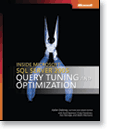I’ve moved my blog here (to sqlblog.com), and thought I’d start with a book review.
This is a post that I’ve been meaning to write for some time, and it seems a worthy first post for this new site. I might go through some of my older posts from my blog at msmvps.com, and maybe even my even older blog at blogspot.com and bring them across, but this is most definitely my first post, even if there are others that look older.
 This book, "Inside Microsoft® SQL Server™ 2005: Query Tuning and Optimization" by Kalen Delaney (and others including T-SQL Tuesday‘s Adam Machanic) is still an excellent resource. Even if you’ve moved across to SQL Server 2008, this book is worth buying and poring over. It is one of those resources that should live on the shelf of every database professional, alongside some of the other classics like Kalen’s SQL Server 2008 Internals.
This book, "Inside Microsoft® SQL Server™ 2005: Query Tuning and Optimization" by Kalen Delaney (and others including T-SQL Tuesday‘s Adam Machanic) is still an excellent resource. Even if you’ve moved across to SQL Server 2008, this book is worth buying and poring over. It is one of those resources that should live on the shelf of every database professional, alongside some of the other classics like Kalen’s SQL Server 2008 Internals.
Being dedicated to performance tuning, it goes deeper into the topic than some of the other areas, including excellent section on traces and locking (areas which I find most people don’t really seem to know much about), in a book which is a lot more compact than it could have been. Considering how much it goes into, the book seems remarkably thin at just 448 pages. If you spend any time tuning SQL Server databases, then this book will feel much thicker than it really is, and you’ll be finding useful information on just about every page. The level of understanding you can get it just as deep as many much longer books, but focussed on making your queries run faster.
Of course, you will want to have a copy of SQL 2005 with you when you read through the book, and probably a copy of SQL 2008 to be able to look at the things that have changed. But the vast majority of things in this book will serve you well for some time, I’m sure.
The link here will help you find the book on MSPress’ Australian site. I’ll also give away a copy of it at a future Adelaide SQL Server User Group event, so if you’re in Adelaide, make sure you keep your eye out for that.
This Post Has 2 Comments
Thanks, Rob!
I’d like to point out Chapter 3 on reading execution plans. It was written by one of Microsoft Engineers on the query processing team (Craig Freedman) and it is amazing! I have read that chapter over 4 times and _I_ still learn new things from it. I don’t there is anything else publicly available that goes into so much depth on what each operator in a plan means, and how to interpret the overall plan. And 99% of it is completely relevant for 2008. Only 4 of the plans are different in the newer version. Because of page count limitations, we were not able to include this chapter in the 2008 book, so you can think of it as a collectors’ item!
~Kalen
It’s a shame that that chapter won’t appear in the next version, it is an excellent one. Even more reason for people to pick up this version still!